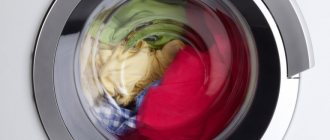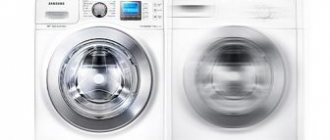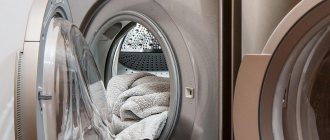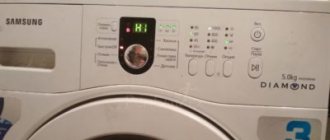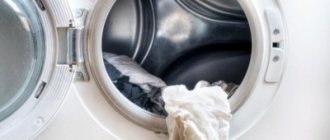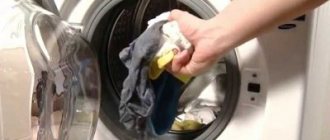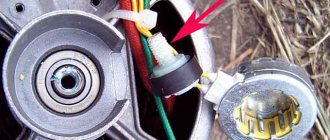Even the most reliable washing machines sometimes break down due to improper use or mechanical problems. One of the main signs of an impending disaster is extraneous noise during washing. Therefore, every owner of these household appliances should know that if the washing machine makes noise during the spin cycle, then it is necessary to immediately look for the cause of this problem and eliminate the malfunction.
Small object or foreign part
The washing machine hums and whistles during the spin cycle due to the fact that some small item has gotten into the space under the drum. Let's look at the main reasons why they get there:
- Clothes pockets are considered one of the main problems. Saving just a few minutes before washing, which you need to spend on double-checking, develops into a real disaster.
- Loading items with buttons, beads, accessories and bras comes with additional risks. Small items of clothing may come off during the main or spin cycle. Try to use laundry bags whenever possible.
- A child can quietly place a toy in the tank or something small in the powder tank.
Important : Always check your clothing pockets before washing.
In the long run, foreign parts can ruin the operation of the machine. To prevent this from happening, you need to extract the excess by following simple steps:
- Disconnect equipment from electricity.
- Remove the top and then the bottom walls.
- Find the heating element, disconnect it and unscrew it.
- Carefully remove all objects and debris from the hole.
- Assemble the car, performing the steps in reverse order.
Most models are equipped with a special sump with a debris filter. As a rule, it is located at the bottom of the front panel. In this case, it is enough to open the door and remove the dirty filter for cleaning. If the washing machine does not start spinning clothes silently, return to parsing.
The laundry inside the drum is unevenly distributed
This problem often affects early models. The clothes bunch up in a big ball and hit the body during the washing process. As a result, an imbalance appears. To correct the situation, you need to pause the washing program and lay out the laundry more evenly. It is worth mentioning that new models from Indesit, Ariston, Samsung, LG and others do not have such problems.
Bearings
One of the most common reasons why a washing machine is noisy during the spin cycle is problems with the bearings. The only element that protects them from water and air is a rubber seal. It is not surprising that over time, leaks occur on the part, and as a result of corrosion, the washing machine begins to whistle and make unpleasant sounds. Usually the oil seal lasts for 5-7 years of stable operation, after which it needs to be replaced.
To detect bearing failure, you need to manually rotate the tank. If you hear a crackling sound or feel play, it is necessary to urgently lubricate or replace the problem unit.
Important : bearing repair is a very labor-intensive process and requires compliance with all manufacturer’s recommendations. If you are not confident in your abilities, it is better to contact a specialist.
Step-by-step instructions for self-replacement:
- You need to start by removing the top and back covers, after draining the water and relieving the voltage from the device.
- Remove the powder dispenser and then carefully remove the control panel. Most often it is secured with simple latches or a few screws.
- Similar to clearing debris, remove the heating element, and then the pipes and counterweight.
- Dismantle the weights that are located below and above the tank to facilitate removal of the drum.
- Remove the belt from the drum and engine pulleys, and then unhook the part from the shock-absorbing springs.
- Carefully remove the assembly and unscrew the pulley to get to the bearing. This can be done using a hammer and a blunt chisel. It is worth noting that in some models you will have to disassemble the drum.
Important : use only lubricants recommended by the manufacturer.
The replacement process is quite simple. It is necessary to remove old parts from the sockets, and then clean the metal rings from dirt. The next step is to install the new parts in place and apply lubricant. A thin layer is sufficient for the seal, but the bearings must be thoroughly treated.
Assemble both the bearings and the seal correctly. The latter, if installed incorrectly, will begin to let air and moisture through again.
Washing machine noise level standards
Depending on the model, washing machines vary in noise level. The noise limit is always indicated in the technical documentation. To reduce sound production, manufacturers equip devices with special systems. The amount of noise produced by the machine depends on the type of drive:
- belt version (gear drive) - volume varies within 60-75 dB;
- direct drive - the sound threshold is reduced to 50-70 dB.
Important! There are no absolutely silent SMAs, but the indicated audibility is quite comfortable for the user.
Identifying a problem by sound
The noise of the SMA intensifies during the spin cycle, since at this moment the drum rotates fastest. If the device has a noise level of 75 dB, excessive volume is completely normal. To determine the fact of a malfunction, listen to the sound:
- increasing, uncharacteristic rumble with each wash;
- very strong vibrations during the spin process;
- a loud noise that sounds like grinding, banging, or clanging.
Metal parts of things can lead to similar sounds. But constant violations indicate serious and minor failures.
When the shaft, oil seal and bearing wear out, screens are accompanied by a change in the color of the water during draining, rusty spots on clothing, leaks and jamming of the drum. Identifying the broken part and fixing it requires professional diagnostics. You can only identify common problems yourself.
Bolts for transporting the tank
To deliver equipment from production to your apartment in good condition, special fasteners and packaging are used. But with a washing machine everything is more complicated, since it consists of many moving parts. Manufacturers install shipping bolts that secure shock absorber springs.
Since the bolts secure the tank in a stationary state, it is strictly forbidden to turn on the machine with them. If the washer is working, it is recommended to cancel the program. It is necessary to unscrew all the bolts located on the rear wall of the machine. The number of clamps is indicated in the instructions; as a rule, there are 4, 3 or 2 of them.
How to remove bolts correctly:
- Unscrew the screws using a simple wrench or adjustable wrench. Loosen them, carefully remove them and store them.
- Close the resulting holes with special plugs or plugs. Otherwise, dust and moisture will enter the washing machine.
Tip : Don't throw away the shipping bolts as they may be needed in the future.
Prevention
In order to invite a technician into your home as little as possible, it is enough to follow simple rules for operating the washing unit. This will not only extend its service life, but also save you from unnecessary hassle. What are these rules?
- Do not overload the machine. It is better to put a little less laundry in it than required according to the instructions.
- Try to do laundry no more than once a day. This will avoid additional stress on the parts. The washing machine will have time to cool down and dry thoroughly.
- Clean all possible filters regularly. You can also install additional water purifiers if necessary.
- Clean your machine from limescale deposits more often. Use special tools for this and follow the instructions.
- If possible, run the boiling program and spin mode at maximum speed as often as possible. If you do this often, components and parts will fail much faster.
- Before putting things in the machine, do not forget to carefully inspect the pockets and folds. Keep buttons and zippers fastened, and use a special bag for washing bras. All these precautions will save you from “fishing out” small objects from the bottom of the drum.
And remember: you shouldn’t delay the repair of the “home laundry”. If you ignore the problem at the initial stage, the matter may worsen and then the repair will cost much more.
See also:
- 10 Best Top Loading Washing Machines
- 10 best Hotpoint-Ariston washing machines according to customer reviews
- 10 best Electrolux washing machines according to customer reviews
- 10 best ATLANT washing machines according to customer reviews
- 10 best built-in washing machines
Failure of the centrifuge rotation axis
The centrifuge is responsible for the movement of the machine drum during washing and spinning. There are many causes of breakdowns, so it is difficult for an ordinary user to fix the problem on their own. Below are the main reasons:
- The tank is overloaded with laundry or water. The rated power of the element is limited, so any load above the norm may cause breakdown. Also, unevenly distributed laundry causes the tank to sway.
- Ingress of foreign bodies that block the rotation of the drum.
- A breakdown of the tachometer is characterized by a sharp change in the number of rotations, too high or low speed, and the items are wet or poorly wrung out after washing.
- The water sensor is faulty - it does not work or gives false readings. Signs include insufficient or excessive amount of water, turning on the heating without water.
The problem can be determined experimentally by first reducing the weight of the laundry per wash. If this does not help, you need to clean the insides of the machine from foreign parts, and then analyze the operation of the sensors and replace the faulty elements.
When spinning, the drum knocks loudly: what can you do yourself?
When the washing machine is operating in spin mode, the rotation of the drum reaches its highest speeds.
Noise and vibration inevitably occur. In some cases, such as improper installation or malfunction of certain parts, it may shake and make more noise than expected. It is not recommended to try to repair serious faults at home, as this risks damaging fasteners, the tank cross and other parts. However, if you notice excessive noise or shaking during washing, follow these steps:
- Switch the machine to spin mode and after it has drained the water, open the drum and remove some of the laundry. Then turn it on again. If the knocking and vibration stop, then the problem was overload.
- Start the unit at idle speed, then turn on the spin program. If the centrifuge continues to rattle, then the problem is most likely a malfunction of the internal mechanisms.
- Bend the hatch cuff and inspect the space between the tank and the drum. If there is a foreign object there, try to remove it.
- Open the filter hole by first inserting the tray. Clean it of small debris.
Has your washing machine started making an uncharacteristic knocking noise? This happens sometimes.
And this is not always a sign of a unit malfunction. Perhaps it is metal or large plastic parts of the laundry (buttons, zip runners, carabiners) knocking against the glass of the hatch and the drum. It is recommended to wash items with large fittings inside out or in special washing bags: this way there will be no knocking or damage to the machine.
If you loaded only soft clothes, and the knocking sound is clearly heard, then there is definitely a problem with the washing machine. Sounds uncharacteristic of washing occur due to a number of malfunctions. Only a specialist can correctly diagnose them, sometimes only with special equipment. But based on some signs, you can figure out on your own what happened to the assistant.
Attention! Before performing maintenance, disconnect the machine from the power supply and water supply!
Counterweight is poorly secured
Also, when spinning, the washing machine makes a lot of noise and rattles due to problems with the counterweight. The part is necessary to make the tank heavier, reduce vibration and provide stability. Counterweights are made of cast iron, plastic or concrete, and the latter break and crumble more quickly.
The most common problem with counterweights is poor fit. Over time, the washing machine, operating at high speeds, weakens the fastening. At the same time, the counterweight begins to vibrate and rattle during the spin cycle.
To solve the problem, simply remove the back panel of the machine and check the tightness of the mounting bolts. As a rule, this helps. If it is visually discovered that the counterweight is damaged, it needs to be replaced.
The drain filter is broken
Owners often encounter unpleasant noise and crackling noises when draining water during and after washing. In order to identify the causes of unpleasant sounds, you should examine the drain system for breakdowns. The most common cause is a malfunction of the drain filter, and this is where the inspection should begin. It is located in the lower right corner of the washing machine and can be reached by opening the door. The filter often becomes clogged with foreign objects, so it should be removed and washed thoroughly. It is necessary to examine the space behind the drain filter and, if contamination is observed, clean it too. If a part is deformed or faulty, it must be replaced.
